| Back to the Plastic Scale Modeling page |

|
|
Sopwith 2F.1 Ships Camel the 1/72 scale Revell kit (suitably modified) by Michael Morrow 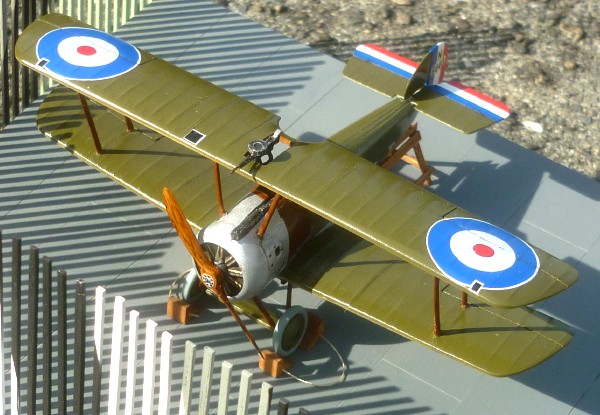
|
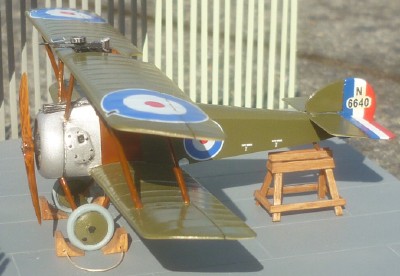 On July 19th, 1918, seven Ship's Camels, each armed with two 50 pound bombs, performed the first carrier strike in history when they took off from the forward flight deck of the aircraft carrier HMS Furious and successfully bombed the German Zeppelin sheds in Tondern, Denmark. The Camels destroyed both sheds, and two Zeppelin airships, which had been bombing London during night time raids.
On July 19th, 1918, seven Ship's Camels, each armed with two 50 pound bombs, performed the first carrier strike in history when they took off from the forward flight deck of the aircraft carrier HMS Furious and successfully bombed the German Zeppelin sheds in Tondern, Denmark. The Camels destroyed both sheds, and two Zeppelin airships, which had been bombing London during night time raids.This display shows one of the seven Ship's Camels ready for take-off from the deck of the HMS Furious on this historic mission. The model was built for a naval aviation model display at the Museum of Flight. |
|
The Ship's Camel The Sopwith 2F.1 Ship's Camel was the Royal Navy's version of the famous Sopwith F.1 Camel. It had a shorter wingspan, different armament, a folding fuselage hinged just behind the cockpit for stowage on Naval vessels, and a small tail wheel on the end of the tailskid to help shorten the take-off run. The Ship's camel was launched off lighters, battleship and cruiser turrets, and aircraft carriers in WW I. For this build, I started with the old Revell 1/72 scale Sopwith F.1 Camel, and converted it into a Sopwith 2F.1 Ship's Camel. This required several modifications. o The Sopwith 2F.1 Ship's Camel had a wingspan that was one foot shorter than the land-based version, so all four wing halves were sectioned to shorten the wingspan by one (scale) foot. Sectioning the wings actually went much easier than I expected it to. o The 2F.1 Ship's Camel's armament differed from the F.1 Camel in two ways. The 2F.1 Camel had only one Vickers gun in the "hump" instead of two, and it had a Lewis gun mounted to fire over the top of the top wing. |
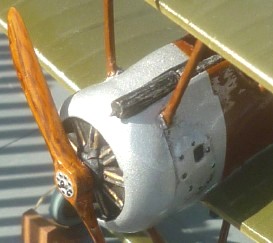 Here you can see the Camel's "hump" has been modified to carry only one Vickers machine gun instead of two. |
|
The 2F.1 Ship's Camel's Lewis gun rotated down on a track through a hole in the wing for re-loading. The track was part of a trapeze structure mounted under the top wing. To replicate this, the proper size hole was cut in the top wing, a Lewis gun was scratchbuilt, and mounted on a scratch-built trapeze, which itself was mounted under the top wing. |
 Here's the scratch-built Lewis gun . . . it's only 9/16 of an inch long! To the right you can see the trapeze it rotates on mounted under the top wing. The entire trapeze structure is only 1/4 inch wide by 1/8 inch tall. |
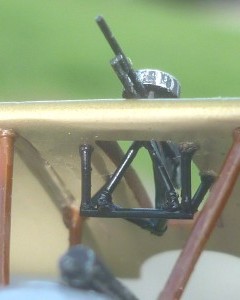
|

Another view of the wing-mounted Lewis gun showing it mounted to the curved reloading track rail. |
|
o For the Zeppelin raid, seven 2F.1 Ship's Camels were converted to bombers by slinging two 50 pound naval bombs under each aircraft. For the model, a 50 pound naval bomb was scaled from photographs in a Harleyford book on WW I aircraft, and two 50 pound naval bombs were then scratchbuilt and mounted under the fuselage. |
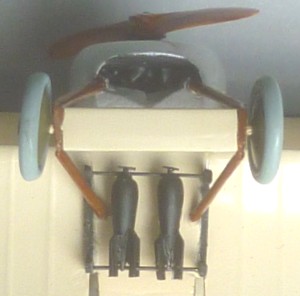 Bombs mounted under the CG of the aircraft . . .
Bombs mounted under the CG of the aircraft . . . |

|
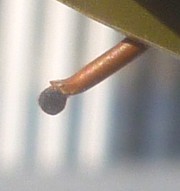
o In order to shorten the Ship's Camel's take-off run from the aircraft carrier deck, a tail wheel was added to the end of its extended tailskid. |
|
o The display base is a section of the right hand side of the HMS Furious aircraft carrier's forward flight deck, looking forward. The right hand side of the deck shows the curvature of the hull as it tapers forward. 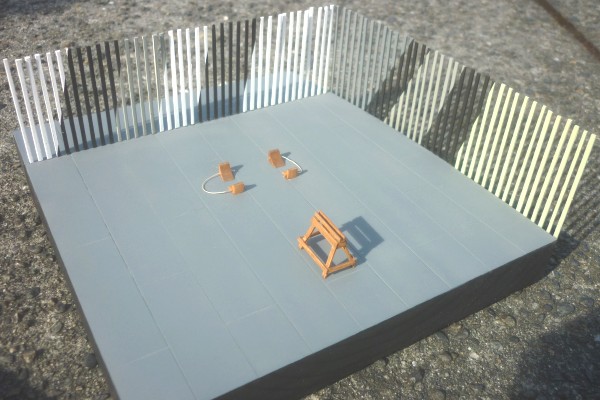
In order to shorten the take-off run, the Sopwith 2F.1's extended tailskid with it's tail wheel was positioned in a slot built into the top of a wooden sawhorse so the aircraft didn't have to use valuable deck run to get the tail into the air on take-off. The wooden slats surrounding the flight deck were retractable wind-breaks positioned in front of the aircraft and on both sides of the flight deck to prevent the light-weight fighters from blowing off the ship before they were ready to launch. When the fighters were ready to launch, the slats were retracted, and handlers kept the aircraft in place till launch. The splinter-style color scheme used on the HMS Furious extended up to include the retractable wooden slats.   The deck is a box structure made from sheet plastic. Deck plates were scribed into the plastic. The wind break slats were cut from 1/32 sheet plywood which gives enough strength to survive handling and masking for painting, and still looks like wood after painting. The side wind break slats were glued to the side of the deck, and the forward slats were inserted in holes and glued to support structure under the deck.
The deck is a box structure made from sheet plastic. Deck plates were scribed into the plastic. The wind break slats were cut from 1/32 sheet plywood which gives enough strength to survive handling and masking for painting, and still looks like wood after painting. The side wind break slats were glued to the side of the deck, and the forward slats were inserted in holes and glued to support structure under the deck.The wheel chocks were cut from basswood, holes were drilled, and white thread was pulled through the holes and knotted on the ends just like real chocks. 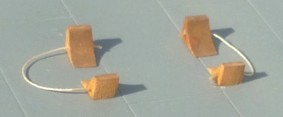 |
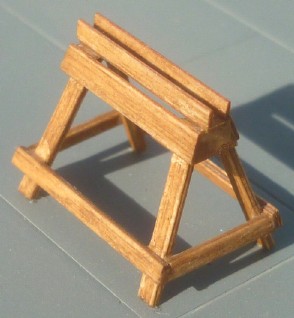
The sawhorse with it's tailskid track on top for take-offs . . . The sawhorse was made from strips of balsa and then stained a wood color. |
o Research into the historic carrier strike determined several of the serial numbers of Ship's Camels that were used on this historic mission, and one of those serials was most likely N6640, so those markings were applied to my Ship's Camel, which completed the display. . . . a Ship's Camel ready for take-off on its historic raid . . . |

|

|

|

|

|

|

|
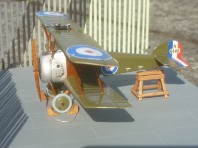
|

|
| Back to the Plastic Scale Modeling page | 
|